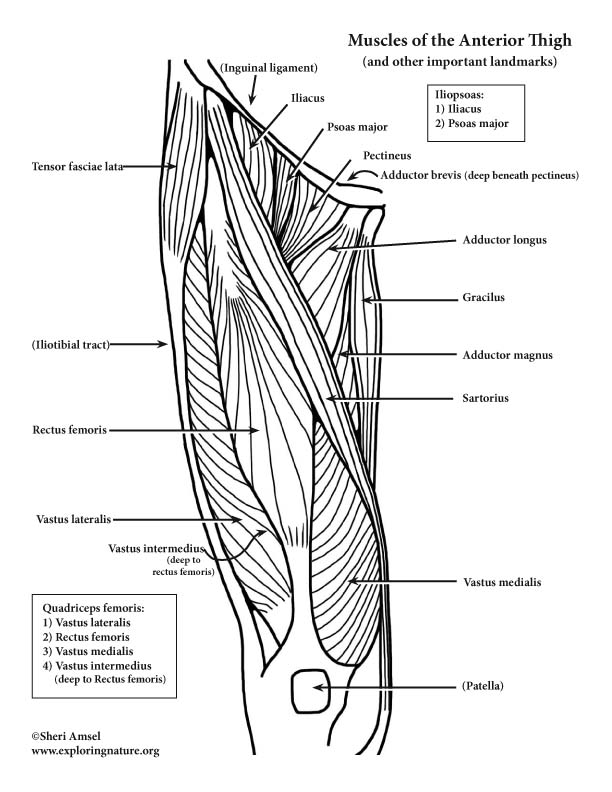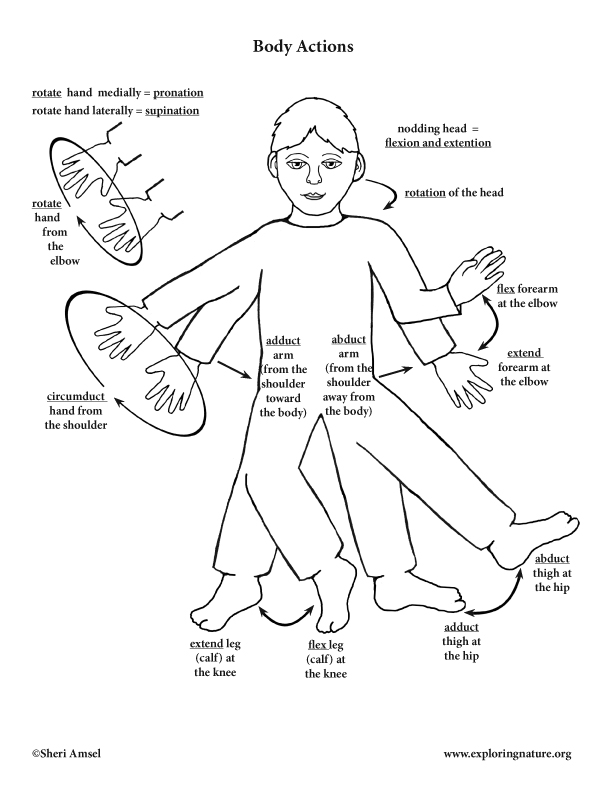

The Muscles Crossing the Hip and Knee Joints
(Anterior View)
l. Anterior Medial (Pelvic) Muscles
Iliopsoas: two-muscle complex: Iliacus and Psoas major
1) Iliacus
a. Actions: hip flexion
b. Innervation: Femoral nerve
c. Origin: from iliac fossa
d. Insertion: to lesser trochanter of femur
2) Psoas major
a. Actions: hip flexion, lateral flexion of vertebral column (posture)
b. Innervation: Femoral nerve
c. Origin: from transverse processes and bodies of lumbar vertebrae
d. Insertion: to lesser trochanter of femur
3) Sartorius
a. Actions: hip flexion, laterally rotates thigh, weakly flexes knee (sitting cross-legged)
b. Innervation: Femoral nerve
c. Origin: from anterior superior iliac spine wind medially around thigh
d. Insertion: to medial aspect of proximal tibia
ll. Muscles of Medial Compartment of Thigh
4) Adductor magnus
a. Actions: anteriorly it adducts, laterally rotates and flexes thigh (at hip), posteriorly it aids hamstrings in extension
b. Innervation: Obturator nerve and Sciatic nerve
c. Origin: from ischial and pubic rami and ischial tuberosity
d. Insertion: to linea aspera
5) Adductor longus
a. Actions: adducts and laterally rotates thigh (at hip)
b. Innervation: Obturator nerve
c. Origin: from pubic symphysis
d. Insertion: to linea aspera (above magnus)
6) Adductor brevis (deep - not see here)
a. Actions: adducts and laterally rotates thigh (at hip)
b. Innervation: Obturator nerve
c. Origin: from ramus of pubis
d. Insertion: to linea aspera (above longus)
7) Gracilis
a. Actions: adducts, flexes and medially rotates thigh (at hip) – especially while walking
b. Innervation: Obturator nerve
c. Origin: from pubis
d. Insertion: to medial tibia inferior to tibial head
8) Pectineus
a. Actions: adducts, flexes and laterally rotates thigh (at hip)
b. Innervation: Femoral nerve and Obturator nerve
c. Origin: from pubis
d. Insertion: to wrap around lesser trochanter of femur (posterior)
lll. Muscles of Anterior Compartment of Thigh
Quadratus femoris: four-muscle complex: Rectus femoris,
Vastus lateralis, Vastus medialis, Vastus intermedius
9) Rectus femoris
a. Actions: extends knee, flexes at hip
b. Innervation: Femoral nerve
c. Origin: from anterior inferior iliac spine
d. Insertion: to tibial tuberosity (via the patellar tendon)
10) Vastus lateralis
a. Actions: extends knee
b. Innervation: Femoral nerve
c. Origin: from greater trochanter of femur and linea aspera
d. Insertion: to tibial tuberosity
11) Vastus medialis
a. Actions: extends knee, stabilized patella
b. Innervation: Femoral nerve
c. Origin: from linea aspera
d. Insertion: to tibial tuberosity
12) Vastus intermedius (deep - not see here)
a. Actions: extends knee
b. Innervation: Femoral nerve
c. Origin: from anterior and lateral shaft of proximal femur
d. Insertion: to tibial tuberosity
13) Tensor fasciae latae
a. Actions: flexes and abducts thigh (at hip)
b. Innervation: Superior gluteal nerve
c. Origin: from iliac crest and anterior superficial spine
d. Insertion: to the iliotibial tract*
* The iliotibial tract is a thickened lateral portion
of the fascia that sheaths the muscles of the thigh
and runs from the iliac crest to the knee.
_____________________________________________________________________________________________________________________________________
Use this study tool to learn the Muscles of the Anterior Thigh: Color the Muscles of the Thigh (Anterior)
Assess your knowlege of the Muscles of the Anterior Thigh: Label the Muscles of the Thigh (Anterior)
_______________________________________________________________________________________________________

